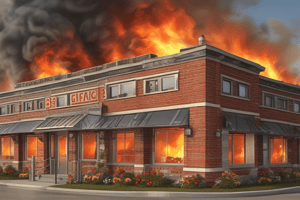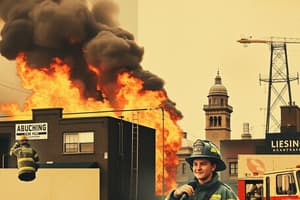Podcast
Questions and Answers
What is the minimum GPM flow rate required for a handline according to NFPA 1710 standard?
What is the minimum GPM flow rate required for a handline according to NFPA 1710 standard?
- 150 GPM
- 1000 GPM
- 500 GPM (correct)
- 250 GPM
In what situation should the fire strategy be changed from offensive to defensive?
In what situation should the fire strategy be changed from offensive to defensive?
- When forecasted conditions prohibit safe and effective suppression (correct)
- When conditions allow for interior fire suppression
- When water application is only possible from external positions
- When handline volume exceeds 500 GPM
What is a key responsibility of the Company Officer during a fire attack?
What is a key responsibility of the Company Officer during a fire attack?
- To provide medical assistance to victims
- To monitor the safety of bystanders
- To direct the attack and determine effective methods (correct)
- To determine the fire's origin
Which of the following is considered a significant challenge when conducting ventilation in commercial fires?
Which of the following is considered a significant challenge when conducting ventilation in commercial fires?
What is the primary purpose of coordinated ventilation in fire control for commercial fires?
What is the primary purpose of coordinated ventilation in fire control for commercial fires?
When utilizing vertical ventilation, what is a primary challenge faced by firefighters?
When utilizing vertical ventilation, what is a primary challenge faced by firefighters?
Which method of water application may be used to improve conditions prior to entry into a fire?
Which method of water application may be used to improve conditions prior to entry into a fire?
What is essential for preventing rapid fire growth with fire companies inside a commercial building during an operation?
What is essential for preventing rapid fire growth with fire companies inside a commercial building during an operation?
What is a primary consideration when conducting fire operations in commercial buildings as opposed to residential buildings?
What is a primary consideration when conducting fire operations in commercial buildings as opposed to residential buildings?
How should commercial fires ideally be approached to maximize the chances of extinguishing the fire?
How should commercial fires ideally be approached to maximize the chances of extinguishing the fire?
In what way do exposure protection operations differ in commercial fire scenarios compared to residential ones?
In what way do exposure protection operations differ in commercial fire scenarios compared to residential ones?
What critical aspect of commercial fires contributes to their complexity and challenges for firefighters?
What critical aspect of commercial fires contributes to their complexity and challenges for firefighters?
What is the recommended flow rate standard for firefighting in commercial buildings?
What is the recommended flow rate standard for firefighting in commercial buildings?
What is essential for a successful rescue operation in a commercial fire situation?
What is essential for a successful rescue operation in a commercial fire situation?
What factor makes search operations risky in commercial fire scenarios?
What factor makes search operations risky in commercial fire scenarios?
What impact does the physical layout of commercial buildings have on firefighting tactics?
What impact does the physical layout of commercial buildings have on firefighting tactics?
Flashcards are hidden until you start studying
Study Notes
Commercial Buildings and Fires
- Commercial structures are classified as places of business, manufacturing, storage, or other non-residential uses.
- These buildings vary significantly in size, complexity, and can be multi-story or connected to other structures.
- Phoenix area commercial occupancies can exceed 1 million square feet, often containing large volumes of content and potential hazards.
Fire Tactics and Life Safety
- Residential fire tactics and flow rates are inadequate for commercial fires; NFPA 1710 recommends higher target flows as the minimum.
- Firefighters have more effective search capabilities in residential settings due to confined spaces, unlike the complexities found in commercial fires.
Strategies for Fire Attack
- Extinguishing the fire remains the top priority for saving potential victims.
- Early fire suppression system support is crucial, along with high water volume and aggressive exposure protection strategies.
- Fire attack should begin promptly, using multiple large-volume handlines (minimum 250 GPM) unless a known rescue operation is underway.
Fire Behavior and Conditions
- Understanding fire behavior is essential; commercial fires produce intense conditions due to large area and content loads.
- The best chance to control a commercial fire is during its earliest stages with a well-executed attack that overwhelms the fire.
Ventilation Considerations
- Coordinated ventilation is imperative for effective fire control, yet poses challenges due to building size and creating effective exhaust points.
- Horizontal or vertical ventilation should be strategically planned, and natural openings like windows and doors may be more effective than vertical methods.
- Cutting adequately sized ventilation holes in large buildings can be difficult, and the Incident Commander (IC) must collaborate with Sector Officers for viable options.
Risk Management and Operations
- Attending to structural stability and reassessing conditions is critical when rescue operations are underway.
- A strategic balance must be maintained between offensive and defensive strategies based on evolving fire conditions.
Coordination and Communication
- Clear communication and coordinated efforts among crews are necessary to manage fire attacks and ventilation effectively.
- The IC and officers must ensure that resources focus primarily on fire containment to prevent rapid fire growth, especially with firefighting teams inside the structure.
Studying That Suits You
Use AI to generate personalized quizzes and flashcards to suit your learning preferences.



